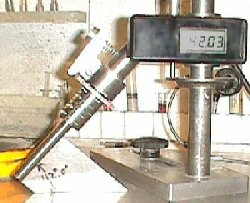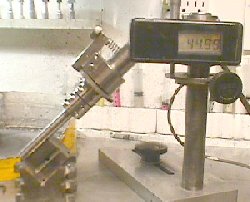The Digital Readout Version.

This was designed to be a retrofit for my "Revision 'H'" faceting head. RevH is my pet. I learned a lot from building Revisions "A" through "F", and they went out with the rubbish years ago. Cate has Rev "G". When I decided to build a beefier one, I used all stainless steel, as I had vowed it was the last change I was going to make. But then....well..you know...:-)
Principle of Operation:
A trimpot and a sensing potentiometer form a simple voltage divider. Designing for 200 degrees of rotation, each degree equals one millivolt. In actual use, the critical measuring is done at that rotational quadrant from 0 to 90o, or from the Table to Girdle settings. Thus, if the pot is linear to 0.5% over its range, only one quarter of its range is really used. If batteries are used, rather than regulated power supplies, it only takes a minute to check the calibration once in a while. Lithium batteries seemed to last forever in this application. The voltage divider only consumes 0.1 milliamp.
Accuracy:
Resolution: 0.01 Degree
Repeatability: Meter limited, usually +/-a few counts from roundoff in the A/D. (Let's be honest: Nobody facets to 10 millidegrees. Some may think so. When you see cutting instructions calling for "41.83 degrees", it's a program artifact. Don't believe me? Inspect any stone with an optical comparator or on an optical bench.)
Linearity error:
Less than 0.125% from zero to 90 degrees.

To the main Gemcutting Page.
Construction Details.
Design principle.
A Digital Panel Meter (DPM) can measure angles to 0.01 degree if a precision instrument potentiometer is used and a stable reference voltage is used.
Choosing a pot:
Some general hints on potentiometer selection:
Carbon pots: No.-Linearity and resolution are critical.
Wirewound Pots: Very good linearity, terrible resolution-Useless in this application. Will not work-Save your time.
Conductive Plastic pots: Various linearity grades are available. Theoretically unlimited resolution. Choose carefully, watch the linearity specs and open your wallet, and you can build a good instrument around one.
Hybrid Pots: The best of the best. A conductive plastic layer over a wirewound element gives nearly unlimited resolution with the good linearity of the wirewound type. Expensive.
Use a potentiometer of at worst 0.5% linearity. Better instrument devices can cost ten times as much, but can sometimes be found surplus. Resistance tolerance is not critical because this pot is used with a trimpot to form a half bridge. Nominally they are 5K Ohms. Generally the larger the pot's physical size, the better the resolution because of more swept dimension.
Disclaimer: This design may be difficult to adapt to certain commercial machines. In addition, making the modifications needed to mount the devices could affect your warranty..Check with your manufacturer.
Further, I have no idea what the commercial machines look like up close- (Not surprising, when you think of it.. )
So your results may vary. As in all such cases, the skills of homebuilders vary. Some will do better: For example, a real electronics guru will no doubt improve on this.
